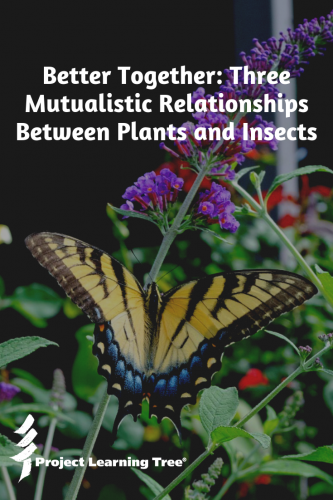 Many organisms share a close relationship built over millions of years of evolutionary history. Some relationships, called mutualism, have worked out to benefit both of the organisms involved. This is especially true of the relationship plants share with insects.
Many organisms share a close relationship built over millions of years of evolutionary history. Some relationships, called mutualism, have worked out to benefit both of the organisms involved. This is especially true of the relationship plants share with insects.
There are three basic types of plant-insect mutualistic relationships: protection, pollination and seed dispersal.
Read more about mutualistic relationships below and bring the lesson to life by exploring different types of symbiotic relationships with Activity 26: Dynamic Duos in PLT’s PreK-8 Environmental Education Activity Guide.
Protection
Ants and plants have a long evolutionary history of partnering with each other. Some plants and ants have been living and working together for so long that the plants have grown special structures to feed or house their helpful friends.
Plants that have a mutualistic relationship with ants are called myrmecophytes, which means “ant-plant.” There are over 100 different species of myrmecophytes. Myrmecophytes have special structural adaptations, called domatia, that provide ants with shelter. One commonly cited example of domatia is the enlarged thorns on Acacia trees that ants excavate and use for shelter. The tree also provides sugary sap for the ants to feed on. In return, the ants aggressively protect the Acacia tree from grazing herbivores.
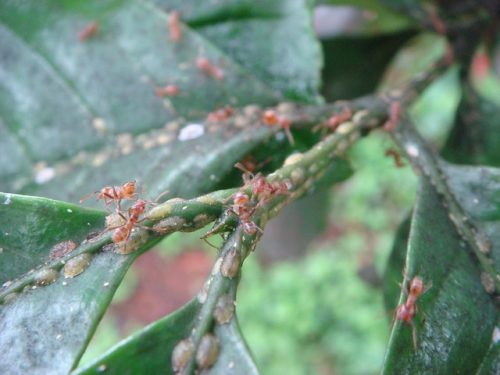
Another plant-ant partnership similar to the ants and the Acacia tree exists in regions of southern Mexico to northern Argentina. Cecropia is one of the most prominent pioneer plants in this area. Their success is largely due to the number of special adaptations, including their intimate mutualistic relationship with Azteca ants (pictured left).
When the Cercropia plants are saplings, Azteca ant queens chew a hole through a small dimple located on the leaf. The plant’s wall is more shallow in this area, so the ants are easily able to excavate at that particular location. Once inside, the queen scrapes the internal tissue and uses it to plug the hole she drilled. Next, the queen will lay eggs and tend to the larvae until the workers emerge.
The Cecropia plants are very fast-growing and produce hollow internodes every one to four weeks. The hollow internodes provide a temperature-controlled habitat for Azteca ant colonies. The ants can use the tissue lining the internodes to make organizational structures inside the internodes. This tissue also provides the ants with a nutritious food source. But that is not the only food that the plant provides to the ants. At the base of each leaf, there are specialized structures that make glycogen-rich food bodies that fit perfectly between the workers’ mandibles. The plants also provide an additional food source under the leaves rich in fat.
In return for the food and shelter, the ant colony defends the tree from herbivores and competing plants. Around the clock, the workers patrol the tree’s stems and leaves. If an insect herbivore is on the tree, the ants will quickly attack it with their sharp mandibles. They will also fiercely attack sloths and monkeys, climbing onto them by the hundreds. In addition to protecting the tree, Azteca ants also clear dirt and bits of debris off the leaf surfaces so that the leaves can better capture sunlight for photosynthesis. If a foreign plant, such as a vine, touches the tree, the ants will destroy the intruding plant’s stem. The ants also fertilize the host by creating refuse piles inside the internodes.
Pollination
Plants have also developed mutualistic relationships with animals to help them successfully pollinate. There are two main ways plants pollinate: wind pollination and animal pollination. Plants such as grasses that live in open areas with lots of wind will utilize wind pollination. The downside to wind pollination is that it is not precise. The pollen could land anywhere the wind blows. Very few grains of pollen land on the stigma of other flowers, let alone flowers of the correct species. To overcome this obstacle, some plants depend on animals for their pollination. Some plants are pollinated by birds, such as the hummingbird. A small number of plants are pollinated by rats. The vast majority of plants, by far, are pollinated by insects.
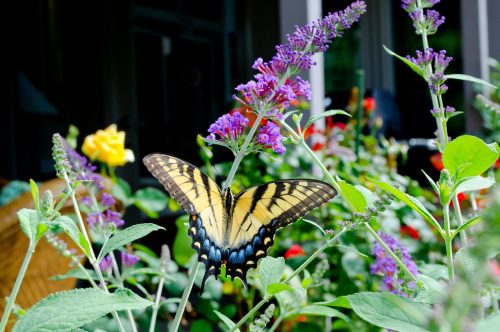 Flowers are the primary way plants attract insects. Bright, colorful flowers attract bees, flies, butterflies, and moths inside the flower to collect nectar and pollen. Some flowers have developed lines on their petals that guide the insects down into the blossom. Other flowers have developed sweet smells that attract pollinators from far away.
Flowers are the primary way plants attract insects. Bright, colorful flowers attract bees, flies, butterflies, and moths inside the flower to collect nectar and pollen. Some flowers have developed lines on their petals that guide the insects down into the blossom. Other flowers have developed sweet smells that attract pollinators from far away.
The color of the flower and its scent will attract specific types of insects. Bees are attracted to yellow, blue, and purple flowers with a sweet, fresh scent. Butterflies prefer red, yellow and blue flowers. Moths focus on colors that are more visible at night, such as white or pale green flowers with a strong, sweet scent. Brown, purple or dull flowers with strong, fruity smells attract beetles. Flies prefer purple or brown flowers that smell like decaying flesh.
The insect’s reward is fairly consistent: they are provided nectar and/or pollen by the plant.
As insects move from blossom to blossom collecting nectar, they spread the plants’ pollen to other blossoms on the same plant and to blossoms on plants nearby. Many plants are not picky about which insects pollinate them. These flowers have open, bowl-shaped flowers where any insect can land, collect, and spread nectar. For example, asters, daisies, and black-eyed Susans have a ray or disc blossom that any insect can utilize. These “open-access” flowers can be used by all sorts of insects, but they are especially used by honeybees, bumblebees and solitary bees to collect pollen by moving around on the inside of the flower in a circle. Sometimes bumblebees will vibrate their wings in these flowers to dislodge pollen. Bees collect the pollen in their “pollen baskets” on their legs.
Other plants are more selective and have structural adaptations that only allow one type of insect to pollinate them. For example, bird’s foot trefoil is a common pea plant grown in North America. Its flower is very complicated, which makes it very difficult for insects to get inside and collect nectar or pollinate. Only bees are able to find their way inside bird’s foot foil trefoil blossoms. In particular, honeybees are the best at finding their way inside. When a honeybee lands on this flower, it immediately notices the guiding lines inside the top petal that point to the base. However, the nectar is not at the base. While looking for the nectar, the bee’s feet open the petals and expose a keel petal inside. The weight of the bee on the keel petal triggers the keel to bounce down like a trampoline which forces the petals to spread apart. The stamens inside the keel are covered with pollen. They pop up and dust the bee’s abdomen. At the same time, the pistol also touches the bee’s abdomen. If the bee has pollen from another blossom, it will stick to the pistol and pollinate the flower.
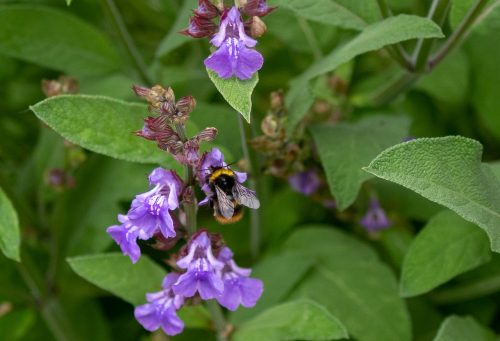
Lipped flowers, such as this sage flower and also members of the pea family, have specialized structures with a lip at the front of the flower that serves as a landing platform. The bee pushes its head into the flower to get to the nectar which is secreted at the back of the flower. At the same time, the flower places pollen on the back of the bee’s thorax. It is very hard for the bee to remove the pollen from this spot. This ensures that the bee carries the pollen from flower to flower for successful pollination.
Plants with small tubular centers, like the Aubrieta, are visited by moths and butterflies. They push their long, thin proboscis into the center of the flower to drink its nectar.
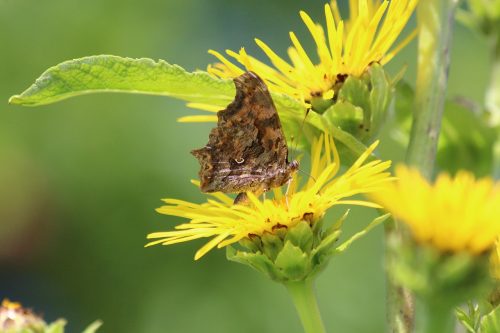
Different types of daisies cater to different types of insects. Some daises have hard yellow button-like centers that consist of tiny florets. These flowers are too small for most bees, so they only attract a small number of pollinating insects. This Inula has small florets that are used as a nectar source by butterflies.
Yucca plants and yucca moths share a very intimate relationship with each other. This relationship is particularly important because the yucca plant and its moth cannot survive without each other. The yucca plant can only be pollinated by the yucca moth. When the female moth is ready to lay eggs, it goes into the yucca flower to collect pollen. Yucca moths have two short tentacles near their mouth that they use to scrape pollen from the plant’s anthers. The moth then packs the sticky pollen into a ball, sticks it under her head and flies to another yucca flower. Once she arrives at the second yucca flower, she heads straight to the bottom of the flower to find the ovary. Then, she creates a small hole in the ovary and lays her eggs inside. After the eggs are laid, the female moth scrapes a small amount of pollen from the sticky ball she has placed under her head. She walks to the flower’s stigma and packs the pollen into tiny depression in the style of the flower. When the eggs hatch, the larvae eat the yucca seeds inside the fruit.
Seed Dispersal
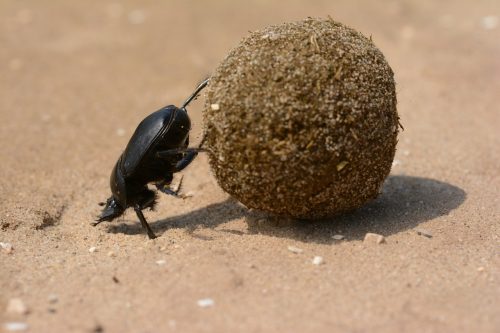 The use of insects to disperse seeds is less common than the use of animals for seed dispersal. However, there are some very interesting relationships of plant-insect seed dispersal.
The use of insects to disperse seeds is less common than the use of animals for seed dispersal. However, there are some very interesting relationships of plant-insect seed dispersal.
Probably the most interesting example of seed dispersal by insects is by the dung beetle (pictured left with dung). These little insects are famous for rolling dung until they find a place to bury it and protect it from dung-eating animals. The dung is eaten later and used for laying eggs. Researchers in South Africa have discovered that the seeds of a plant called Ceratocaryum argenteum mimic a piece of animal dung. These seeds are hard and pungent-smelling, very similar to antelope dung. The scent and appearance trick the dung beetles into thinking they found animal dung. Dung beetles roll the seed away and help the plant colonize new areas.
Other species of plants in South Africa depend on ants for seed dispersal. Ants collect seeds and bring them to their nests. The seeds that are dispersed by ants have small structures, called elaiosomes, on the outer surface that attract ants. Ants do not harm the seed by eating the elaiosomes. In fact, in some cases the seeds germinate more easily once the elaiosomes are removed by the ants.
Other plant seeds are dispersed by beetles, wasps, thrips and some moth species. Seeds can be dispersed by simply knocking the seed from the plant to the ground. In other cases, seeds can be carried greater distances from the plant. Some insects use seeds for other purposes.
The seeds of Cadagi Eucalypt trees, a native of Australia, contain resin that bees use for building their nests. When the bees collect the resin, they inadvertently take the sticky seeds along also. The bees promptly discard the seeds as soon as possible so that they do not block their nests. Since the bees forage quite a distance from their nests, the seeds can be cropped a considerable distance away from the parent plant. Of course, this helps the plant only if the seed lands in a suitable location for growth.
These unique and specialized symbiotic relationships are fascinating subjects for further research and discussion and many of the plant-insect partnerships that are useful for pollination can be observed in the gardens and fields near you!
Additional PLT Activity Suggestions
For more ideas and activities exploring symbiotic and mutualistic relationships in nature, check out the following in PLT’s PreK-8 Environmental Education Activity Guide:
- #7 – Habitat Pen Pals
- #11 – Can It Be Real?
- #43 – Have Seeds, Will Travel
- #8 – The Forest of S.T. Shrew
You can also review our additional STEM teaching techniques for Have Seeds, Will Travel, and download an adapted version of The Forest of S.T. Shrew. These are supporting resources for the full activities, which include online or in-person professional development training.


